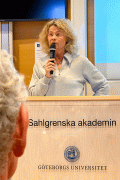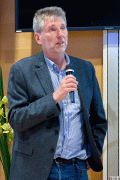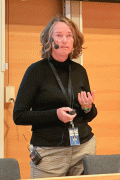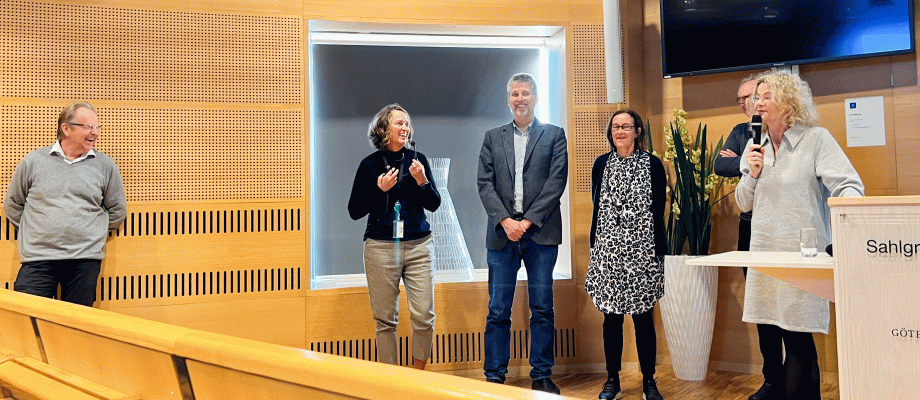FACULTY DIALOGUE. A pleasant discussion and many insightful questions. This is how Dean Agneta Holmäng summarized the general academic meeting with a focus on the conditions for our researchers and renewal. The meeting took place over lunch on Tuesday, October 10.
The meeting commenced with an overview of the activities currently available for researchers in the early stages of their academic careers at Sahlgrenska Academy. Ellen Rydberg, Lena Carlsson Ekander, Martin Lagging, Henrik Hagberg, and Gunnar Tobin all provided brief presentations. Some of the background presented can be read in the article “How Sahlgrenska Academy nurtures new research talent” published in Akademiliv on September 26.

The remainder of the meeting was dedicated to collegial discussion. Many colleagues from various parts of the faculty and different phases of their research careers posed questions and provided input to the panel. Akademiliv here provides details on some of the comments and questions that arose during the meeting.
The Importance of International Experience

Lena Carlsson Ekander noted that the competition for establishment grants from the Swedish Research Council is fierce, as evidenced by the very high grades from the VR’s (Swedish Research Council) evaluation groups for the projects. She presented a compilation for researchers who received this grant in a specific year, illustrating that certain factors stand out for those who have been successful in their applications. Most had a publication as the first author in an absolutely top-tier journal. An overwhelming majority had also undergone a period as an international postdoctoral researcher.
“It is challenging to succeed without international experience. We also see that a genuinely excellent publication is much more important than several mediocre publications,” said Lena Carlsson Ekander during her presentation.
Leo Stockfelt, a researcher and specialist physician in occupational and environmental medicine, pointed out that, especially in clinical research, it can be successful to combine clinical work with research part-time. The panel agreed that a more extended postdoctoral period abroad may not always be necessary for success, but even shorter periods, perhaps a few months, can make a significant difference for a researcher in building the international contacts and networks required.
Newcomers or Returnees
During the discussion, Thomas Carlsson, a researcher in the Section for Pharmacology, highlighted two tracks regarding the recruitment of researchers with international experience. Firstly, researchers who have completed their doctorate at Sahlgrenska Academy, whom they would like to return and establish themselves here after an international postdoc. Secondly, other internationally successful researchers with no previous connection to Gothenburg. He wondered which of these tracks is more important for the faculty. Perhaps it would be an advantage if the faculty is clear that there are opportunities for talented researchers who wish to return?
Agneta Holmäng and Lena Carlsson Ekander agreed in their response that both of these groups are equally important for the growth of the faculty. The faculty aims to recruit the best researchers, regardless of whether they completed their doctorate at Sahlgrenska Academy or not. The institutions keep track of researchers who are on an international postdoc and hope to reconnect them to their research, they said.
Quotas or Not
The question of project-bound doctoral positions was raised by some attendees. Previously, some of these positions were allocated to junior researchers, but these quotas have ceased. A review by Future Faculty showed that it has become more challenging for early-career researchers to obtain these internal grants. This image was confirmed during the meeting by, among others, Cristina Maglio, a researcher in the Department of Rheumatology and Inflammation Research. She suggested that it has become so difficult for junior researchers to get these doctoral positions that many choose not to apply.

Martin Lagging, Vice Dean for Research Education, responded that the attempts made with quotas at the faculty have not worked. When the project-bound doctoral positions were introduced in their current form in 2007, at least two positions were set aside for younger researchers, defined at that time as a person under 40 years who was a docent but not a lecturer or professor. Later, “junior researchers” were redefined after the time since the doctorate (up to eight years, excluding sick and parental leave, as well as military service). In addition to quotas for junior researchers, there were also quotas within knowledge areas and for clinical research. These quotas placed a significant burden on administration and considerable frustration for those who just missed being included in the favored group. All quota groups were abolished in 2010.
One Announcement Instead of Two
Martin Lagging also emphasized that the focus is on ensuring that doctoral students and postdocs have the best opportunities for their research and research education, and therefore, it is the quality of the projects that should determine which research groups are allocated positions.
Agneta Holmäng added that the system where some faculty funds are used for project-bound positions for doctoral students and postdocs is unique to the Sahlgrenska Academy. No other medical faculty in Sweden has this type of internal funding. Perhaps the faculty should also open the discussion about whether this is the best way to invest faculty common funds or whether they should be used differently.
From next year, the project-bound positions for postdocs and doctoral students will be announced once a year instead of twice. By making the announcement in the fall, the faculty wants to provide an opportunity for researchers to focus on their VR (Swedish Research Council) applications during the spring.
“The total number of positions will be the same, but since it becomes a more consolidated pot, I think there is a greater opportunity for the evaluation group to take more into account the career phase of the applicants, which I believe they already unconsciously do today,” said Martin Lagging during the meeting.
ERC and SSMF
Anna Rudin, professor and deputy head of the Institute of Medicine, was interested in the commonalities among researchers who received the Swedish Research Council’s establishment grant. She wondered if similar compilations had been made for other grants, such as SSMF, but received a negative answer. Elias Eriksson, a member of the evaluation group for SSMF, took the opportunity to suggest that the competition within the clinical track for grants from SSMF is not as significant, and several researchers from Sahlgrenska Academy should be encouraged to apply for this. SSMF has also made the clinical track more flexible so that one can go away for a few months at a time and then return to facilitate the combination with a clinical position in Sweden.
Magnus Simrén, a professor in the Department of Molecular and Clinical Medicine, noted that his own generation of researchers has not been very successful regarding grants from the European Research Council (ERC). How is the faculty investing to ensure that the next generation of researchers is more successful with European research grants?

The Research and Innovation Office works specifically with ERC, Ellen Rydberg explained. It is essential to identify potential researchers who can apply early. At the Sahlgrenska Academy, the Department of Research Support works, among other things, on developing funding plans together with researchers.
“Young researchers need to be aware that this requires planning so that they don’t have to rush and can create really good applications,” said Ellen Rydberg during the meeting.
Next Meeting on December 11
Already now, you can mark the next General Academy Meeting on your calendar: Monday, December 11, will focus on the costs of our scientific publications, including the participation of Chief Librarian Morgan Palmqvist.
BY: ELIN LINDSTRÖM











